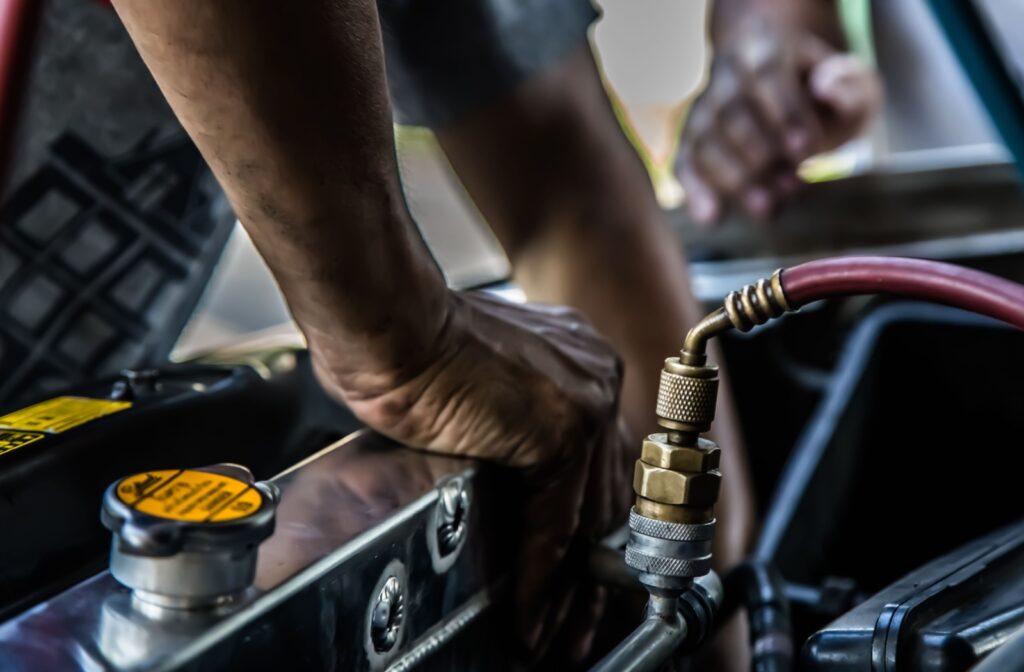The radiator is one of the most crucial parts of your engine; it helps keep the engine cool and functioning properly. However, the radiator is not invincible. They can be vulnerable to leaks, cracks, and other damage over time, especially when put under high-stress conditions. This is why learning when and how to replace your radiator is essential.
Inspect your radiator often for any signs of damage, and make a point to constantly check and top off your coolant levels. Flush the radiator occasionally to remove any buildup or debris. If you ever notice a problem with your radiator, do not try to repair it yourself. Instead, contact a team of experienced professionals like ours at Northland Radiator.
Why Is It Important to Maintain a Radiator?
A radiator’s primary function is to keep your engine cool. Simply put, the radiator takes heat generated by the engine and cycles it to the outside air, helping keep the engine running at an optimal temperature.
While this process may seem simple, it can be quite complex. Radiators—especially those designed as a heavy-duty solution for industrial-strength engines—are designed to withstand stressful environments. However, they are not invincible; this means that they can be at risk of failing.
If your radiator fails, it can lead to:
- An overheating engine which can cause significant damage and reduce the engine’s lifespan.
- Reduced engine performance as the engine struggles to operate at its optimal temperature.
- Increased fuel consumption since a poorly cooled engine requires more fuel to maintain power.
- There is a potential for engine seizure, a serious issue that can result in costly repairs or the need for a complete engine replacement.
This makes it crucial to learn to properly maintain your radiator.
Tips for Maintaining Your Radiator
Regular maintenance helps keep your radiator running, which can keep your vehicle on the road. So, how do you maintain a radiator?
It helps to:
- Check your coolant levels regularly, and top it off as needed. Make sure to use the correct coolant, as the wrong type can lead to inefficiency and potential damage.
- Inspect the radiator for leaks, corrosion, or any visible damage. Over time, damage can affect its performance; catching these issues early on can prevent significant issues later on.
- Keep the radiator clean. Debris and dust buildup can lead to plugs and clogs in the radiator. Clean it regularly, especially after driving in dusty or dry conditions.
- Flush the radiator when needed. Over time, sediment and contaminants can build up in the radiator. Regular flushing can help maintain an efficient radiator.
- Make sure the radiator is secured. Loose parts or vibrations can lead to significant damage over time.
If you notice any visible damage or problems with your radiator, it is time to assess the situation and determine whether you need to replace it.
How to Tell if You Need to Replace Your Radiator
Knowing when to replace your radiator can save you a world of trouble and potentially save your engine from damage.
The most common sign of a radiator problem is an overheating engine. Remember, the radiator is supposed to disperse excess heat from the engine to maintain temperature. If the engine is overheating, the radiator is no longer doing its job. Keep a close eye on the temperature gauge to determine whether or not your engine is regularly overheating.
There are several other signs to watch for:
- Coolant leaks: Check underneath your engine when the vehicle is at a standstill. If you see a puddle of liquid matching the colour of your coolant, you may have a radiator leak.
- Discoloured coolant in the radiator: If your coolant appears rusty, the radiator may have corrosion, indicating the need for replacement.
- Sludge or a consistency problem with the coolant: This can indicate that dust, debris, dirt, and other contaminants are building up inside the radiator.
- Damage: Any visible cracking or damage to the radiator and surrounding parts.
If you notice any problems with the radiator, you should immediately consider repairs. Driving with a damaged radiator can lead to serious engine problems. In some cases, it may be possible to repair the radiator, but replacing the radiator is usually the best option if the damage is severe or beyond repair.

How to Replace a Radiator
Attempting to replace a radiator yourself can be a daunting task. This is rarely a fix that can be done by yourself; you need:
- An in-depth knowledge of how cooling systems work
- Understanding of the different components of a radiator
- A proper diagnosis
- The right tools
- A high understanding of safety measures
If you are not careful, this can quickly become an intricate task. Radiators are complicated, and if disassembled or assembled improperly, they can lead to significant damage and harm.
This is why it is essential to visit an experienced professional when you need to repair or replace a radiator. Replacing, removing, or repairing one yourself can quickly lead to significant problems, so leave it to the professionals here at Northland Radiator. Our team has more than 43 years of radiator repairs under our belts, and we can help.
Let Our Team at Northland Radiator Help
Your radiator is a crucial part of the engine; it helps keep your vehicle on the road. If you are experiencing any problems with your radiator, contact our team here at Northland Radiator. We can repair or replace your radiator. Get in touch with our team today; your engine will thank you.
